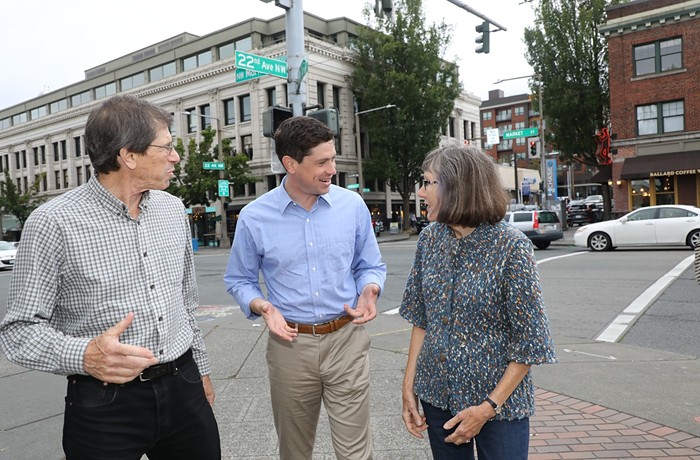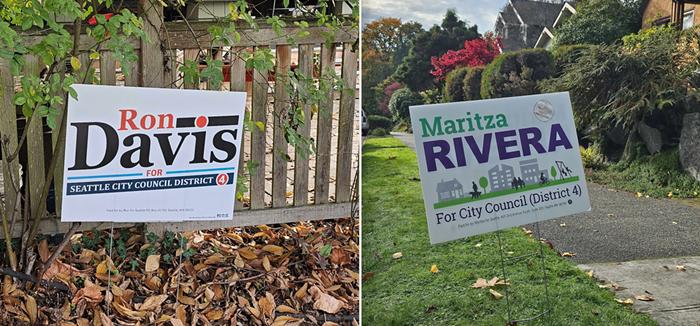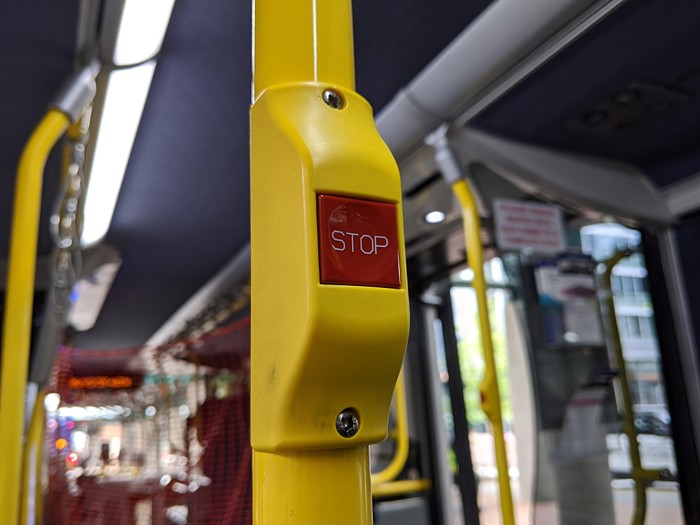In Instant Litter, his book about the golden era of Seattle posters, designer Art Chantry wrote about how the posters stapled to telephone poles all over town were patently not aimed at the general public: "The artists... preferred to post in very specific neighborhoods, where the images scared off common folk and caught the attention of those who understood," he wrote. "The result was more of a community primal scream than advertising."
Chantry wasn't the only graphic designer to rise from the punk era, but he was one of the most successful, going on to design work for more mainstream events and organizations--the Bumbershoot poster he designed, with illustrations by Ed Fotheringham, is a minor masterpiece--and eventually on to a retrospective at the Seattle Art Museum, complete with poster-covered telephone pole transplanted to the middle of a museum gallery. Chantry, who was frantically, almost rabidly opposed to the digital revolution in design, always maintained an ambivalent relationship to the success of his work and the scenes it promoted (that was him in Hype, chopping up collector's-item-status posters with a paper cutter), and it's hard not to look at this new generation of sleek, glossy, mostly computer-produced posters and not wonder what he would think.
Poster art didn't die during the ban, but it certainly withered. The posters that flourished were the more expensive kind, produced by established designers, commercially printed, and hung in sanctioned areas; what was lost was the fly-by-night kind of populist poster that is as fleeting an art form as it is visual. Pre-ban, postering was a no-barrier activity--anyone with the inclination and access to a Xerox machine could do it--and the nuisance value of postering played right into punk's anarchic tendencies. But it also served a more important purpose, that of making people aware of the city's subculture. Current poster artist (and pop performer) Saskia [see "Itzatomic Darling," below] told me as much when she said, "When I was a kid, I'd walk around the city, and my life sucked, you know, and I didn't have any access to information. But then there would be this image, and it allowed me to know there was a world out there." What she's talking about are the accidents of discovery that build an authentic scene.
These accidents, this mess of culture, is partly what accounts for the fear that fueled the ban's supporters. The argument for banning posters (the safety of City Light workers) was a convenient front for a bossier, more civic argument that was, depending on your point of view, a desire for either a clean, friendly city, or a sanitized, mall-like one. Hence 1994's poster ban, overturned last month by the court of appeals, which declared telephone poles a "traditional public forum."
This could all be meaningless... if the city attorney appeals the repeal, and if the state supreme court reinstates the ordinance. But what's appearing on telephone poles in the city--and it's by no means gathered the steam it once had, when there would be a solid inch's worth of stapled-over posters from years back, an exercise in pop anthropology for anyone who cared to peel back the layers--shows us that the art of postering isn't dead, just waking up and stretching its atrophied muscles.
Chantry is long gone, having left Seattle in a kind of public snit, declaring, "It's become a city of assholes and whores" [Evan Sult, "'Tis Pity She's a Whore," The Stranger, May 18, 2000]. So far, no new Chantrys have emerged, but it's early yet, and the field is wide open. There's certainly a greater self-consciousness about it--pretty much everyone in the world knows that a well-designed poster, or even a not-so-well-designed poster associated with some seminal event can bring a kind of enduring fame--and in the years since the ban went into effect, design software has become something anyone can use. The result so far is mixed: some good work, some uninteresting work (everyone's out of practice, after all), but definitely varied and inspiring and hopeful. There's a wild mix of styles, swinging from the ultra-sleek to the DIY homage, which is appropriate; the music world is more pluralistic, and at the same time more specialized, creating a chatter of simultaneous scenes.
What follows are a few of the posters I've seen in Month One of post-ban Seattle, some good, some less so, overall a terrifically good and happy and optimistic thing. And the more posters that go up, the better they're going to get.
A blip of digital light against an inky dark background with only a web address as a guide absolutely screams (although quietly) electronica. This was one of the first posters to appear in multiples (really: you saw it everywhere) after the poster ban was repealed. By itself, this poster doesn't do much, and its aura of mystery is a little overly self-conscious, but as a contrast to the text and image-heavy posters that surround it, it's a relief.
2-3. Graceland's Monday Funday and Jesus Disease
The all- (or mostly) text poster takes one of two forms. Monday Funday's version harks back to a kind of Victorian/Gay-'90s aesthetic, with text as the main visual element, usually in varying fonts, varying sizes--think of old-fashioned circus posters. The small-type paragraph, as used by Jesus Disease--a long paragraph marooned in the middle of a large sheet of paper--is a more aggressive approach, suggesting a rant of barely compressed rage, requiring attention, time, and perseverance on the viewer's part (the poster I saw was so high up as to be quite unreadable). The all-text poster tends to be hard to read, but it communicates an appealing intensity, a feeling there's a lot going on. It demonstrates the gap between how a poster functions aesthetically and how it functions as a vehicle for information--and seems to delight in the contradiction.
4-5. Biography of Ferns (et al.) and Hung Dice
It looks cleaner and has a little whiff of Quark about it... but this poster is a DIY throwback to the Chantry era. It uses the same intuitive/nonsense model of pairing text and image that comes directly out of Dada and drove the poster imagery of the late '70s to mid '80s. The Biography of Ferns poster is balanced and not bad to look at, but not particularly eye-catching either. (You have to ask: How will this do surrounded by eight million other posters?) And I wonder if the image of a chimp at a keyboard refers to the way posters are made. Some posters are even more lo-fi, so much so that DIY is an overstatement. The Hung Dice poster is aggressively amateurish, with handwritten text and a slapdash drawing. Not only does it reject the digital method, but it also says, "We couldn't find a pair of scissors." The poster text ("benefit for our tour show--we'll pass the hat") tells you that this band is really winging it, and it's hard not to be touched by such homegrown energy.
6-7. Slink and Bonafide!
These posters, while not the most exciting works around, are great examples of what the digital revolution has wrought. Multiple fonts, slick images, crammed layout--they say, "I've got a computer, and I will use it!"
8. Michael Gira (et al.)
This gorgeous poster is brainy and artful, as well as beautifully produced--screen-printed on heavy paper, in deep black and bright saturated yellow. Gira's name has been turned into a textual trope, a repeated command that echoes through different sizes and, in one tiny spot, a different font, ornate and elegant. The box shapes both do and do not contain the text, which gives an awkward (but not unpleasant) feeling of movement to the poster. These graphics refer to, without directly imitating, the Futurist and Constructivist posters of the '20s, and that such a lovely thing was brutally taped to a metal pole adds a slight air of transgression and history.
9. No. 2, The Minders, The Shadow Mortons
This horizontal poster (going against the usual grain of the vertical format) has amazing visual energy: enervated line drawings, in black against a grass-green background, of what may or may not be a party: men drinking, gesturing, watching what may or may not be a fight (feet, legs, an ass) at the center of the poster. In the foreground, two men look out of the poster, one aggressive, giving us the finger, the other contemplative, smoking two cigarettes. I love this poster. It's engaging, artfully confrontational, beautifully arranged without calling attention to anyone's design skill. Hooray for this designer, whoever it is.
10. Itzatomic Darling
This photocopied 8" x 10" image of a woman dressed in a torchy k.d. lang style (muscle shirt, suspenders, pin-striped pants, long bang of hair, cigarette with a fragile extended ash, intimate/confrontational gaze) looks like a campy headshot, and is inscribed accordingly: "all my love."
I like this piece for its pure propaganda quality--no club date, no message, no identifiable information--and its quietness among the riot of promotional posters on the already packed telephone pole. The surreal quality of a piece of advertising that doesn't tell you anything simply fucks with your expectations, and may in the end get more of your attention than the kind of advertising you can readily understand.
11. Pho Bang
Jesus, what's not to love here? Linda Evans half-assedly annotated with a Salvador Dali moustache, blackened teeth, and Mansonish forehead cross, with show information handwritten in angled '80s metal-band letters. Undesigned, un-thought-out, unconcerned with aesthetics, this poster doesn't care what you fucking think of it, it just wants you to pay attention.


















